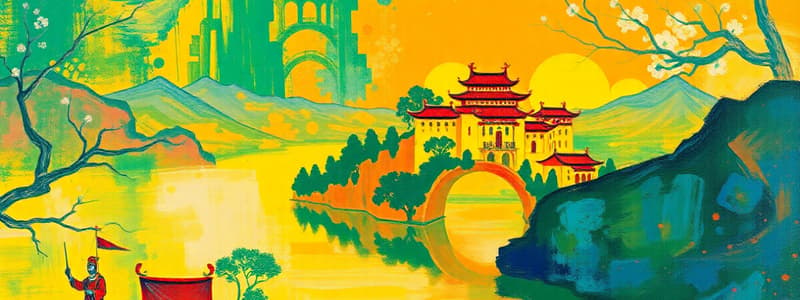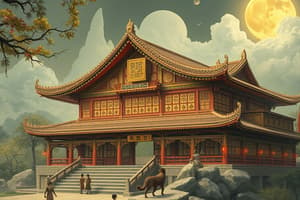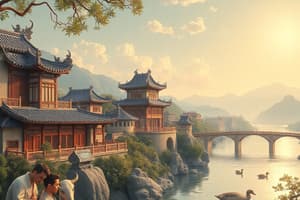Podcast
Questions and Answers
What material is primarily used to make Chinese porcelain?
What material is primarily used to make Chinese porcelain?
- Flax
- Kaolin (correct)
- Hemp
- Clay
Which of the following was first cultivated by the Chinese for medicinal purposes?
Which of the following was first cultivated by the Chinese for medicinal purposes?
- Tea (correct)
- Silk
- Banana fibre
- Hemp
What invention is associated with the ancient Chinese civilization?
What invention is associated with the ancient Chinese civilization?
- Abacus (correct)
- Steam engine
- Electric motor
- Printing press
Which statement about the decline of the Chinese civilization is accurate?
Which statement about the decline of the Chinese civilization is accurate?
Why was silk production a closely guarded secret in ancient China?
Why was silk production a closely guarded secret in ancient China?
Which river is known as the 'sorrow of China' due to its destructive flooding?
Which river is known as the 'sorrow of China' due to its destructive flooding?
What characterized Chinese society during the Shang and Chou dynasties?
What characterized Chinese society during the Shang and Chou dynasties?
What development occurred in Chinese society during the Chin dynasty?
What development occurred in Chinese society during the Chin dynasty?
Which dynasty is considered the earliest Chinese kingdom based on archaeological evidence?
Which dynasty is considered the earliest Chinese kingdom based on archaeological evidence?
What primary economic activity supported the Chinese civilization during its early development?
What primary economic activity supported the Chinese civilization during its early development?
What role did women primarily have in early Chinese society?
What role did women primarily have in early Chinese society?
Which dynasty followed the Shang dynasty in chronological order?
Which dynasty followed the Shang dynasty in chronological order?
What was a significant impact of the Huang He's changing course on settlements?
What was a significant impact of the Huang He's changing course on settlements?
Which of the following crops were primarily grown by ancient Chinese farmers?
Which of the following crops were primarily grown by ancient Chinese farmers?
What was one of the primary uses for animals domesticated by the Chinese?
What was one of the primary uses for animals domesticated by the Chinese?
Which of the following goods was NOT sold by China along the Silk Route?
Which of the following goods was NOT sold by China along the Silk Route?
What important invention did the Chinese create to improve horse control?
What important invention did the Chinese create to improve horse control?
How did the Chinese initially represent words in their writing system?
How did the Chinese initially represent words in their writing system?
Which philosopher greatly influenced Chinese life and established key principles of respect and sincerity?
Which philosopher greatly influenced Chinese life and established key principles of respect and sincerity?
Which religion saw a significant rise in popularity towards the end of the Han dynasty?
Which religion saw a significant rise in popularity towards the end of the Han dynasty?
What was one of the achievements of ancient Chinese astronomy?
What was one of the achievements of ancient Chinese astronomy?
What material did the Chinese initially use for writing before the invention of paper?
What material did the Chinese initially use for writing before the invention of paper?
Which architectural structure is known for its role in storing sacred relics?
Which architectural structure is known for its role in storing sacred relics?
Which significant achievement in Chinese civilization involved the creation of explosive materials?
Which significant achievement in Chinese civilization involved the creation of explosive materials?
What important feature was included in the Great Wall of China?
What important feature was included in the Great Wall of China?
In ancient Chinese painting, what materials were used to create colours?
In ancient Chinese painting, what materials were used to create colours?
What did the Chinese script primarily consist of?
What did the Chinese script primarily consist of?
Flashcards are hidden until you start studying
Study Notes
Origins and Development of Chinese Civilization
- Chinese civilization began around 1700 BCE along the Huang He river, northern China, thriving in isolation due to geographical barriers.
- Rich alluvial soil from Huang He facilitated agriculture, leading to the development of permanent settlements that evolved into cities.
- The river's frequent course changes caused destruction, earning it the nickname “sorrow of China.”
Dynastic Timeline
- The Shang dynasty (1700-1027 BCE) was the earliest known kingdom, followed by the Zhou (1027-256 BCE), Qin (256-206 BCE), Han (206 BCE-220 CE), and Tang (618-885 CE).
- Periods of internal unrest occurred between dynastic rules.
Social Structure
- Society during the Shang and Zhou was divided into nobles (warriors) and peasants.
- By the Qin dynasty (3rd century BCE), social classes expanded to include merchants and craftsmen, with the army emerging as an influential class.
- Family units were significant; work was divided between men and women, with women managing domestic affairs and men primarily farming.
Economy and Occupations
- Agriculture was the cornerstone of the economy, with irrigation systems developed by 500 BCE and ox-drawn plows in use by 400 BCE.
- Common crops included rice, millet, and wheat, with animal husbandry for labor and food.
Trade Networks
- Ancient trade occurred mainly along the Silk Route, connecting China with distant territories including the Black Sea, Persia, and India.
- China exported silk, ceramics, jade, and tea, while importing gold, ivory, and glass; metal coins facilitated trade.
Transportation Methods
- Horse-drawn chariots and invented stirrups improved transport; palanquins were used for passenger movement.
Writing and Literature
- Early Chinese writing began with pictographs, later simplifying into thousands of symbols; traditionally, writing was done vertically.
- Calligraphy emerged as a highly regarded art form, evolving from bamboo writing to paper with its invention in the 1st century CE.
Religious Practices
- Ancestor worship and nature deification were prevalent; tombs contained the deceased along with objects for the afterlife.
- Confucianism emerged in the 6th century BCE, emphasizing respect and tradition, becoming state philosophy during the Han dynasty.
- Buddhism gained popularity in the 3rd century CE, fostering the establishment of monasteries and translation of texts.
Scientific and Technological Achievements
- Ancient Chinese astronomers developed accurate instruments, predicting eclipses and formulating a calendar based on lunar and solar cycles.
- Gunpowder was discovered around 850 CE, initially for celebrations before military applications arose.
- Paper-making techniques evolved around the 1st century CE; block printing was developed by 700 CE.
Arts and Crafts
- Metalworking, particularly in bronze and iron, was advanced; jade artifacts have been crafted since the Neolithic age.
- Chinese painting transitioned from decorative styles to realistic portrayals, using natural pigments and fine brushes.
- Architectural designs followed philosophical guidance, with pagodas and the Great Wall exemplifying distinct features.
Innovations and Contributions
- The Chinese were pioneers in sericulture (silk production) and developed high-quality silk textiles.
- Porcelain, created from kaolin clay, achieved international acclaim, leading to the term "china" for such pottery.
- Notable inventions include tea cultivation, watermills, acupuncture, and the abacus.
Continuity and Decline
- Unlike other civilizations, Chinese civilization maintained continuity without collapse, adapting through various dynasties until the 1949 establishment of the Republic of China.
- Traditions and cultural features from ancient times persist in modern Chinese society.
Studying That Suits You
Use AI to generate personalized quizzes and flashcards to suit your learning preferences.




